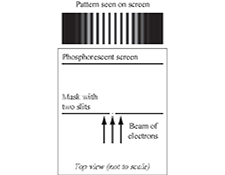
Wave properties of matter
Variant i Dynamics first
Developed by Bradley Ambrose (creator) and Stamatis Vokos (creator)
The tutorial covers the wave properties of electrons in the context of a two-slit interference experiment.
Topics Modern and quantum / Modern physics: models, operational definitions, physical optics, and modern physics
Materials
Materials by the UW team
- Equipment List

- Instructor’s Guide


- Sample Pre-test


- Handout


- Sample Exam Questions



Tutorial details
Students begin with a review of two-slit interference of light. Using diagrams of light from two slits, students recall which values of path length difference (in terms of λ) give maximum constructive interference and which give complete destructive interference. Students are then given two photographs of interference patterns. The first pattern is identified as the original pattern on the screen; the second is identified as the new pattern on the screen after a single change has been made to the experimental apparatus. The distance between the maxima and minima is greater in the second pattern than in the first, but not twice as great. Students use geometrical reasoning to conclude that if the change made to the apparatus was a change in wavelength of the incident light, the wavelength must have increased, and the increase must have been by less than a factor of two. If, however, the change was to the slit separation, the slit separation must have decreased by less than a factor of two. At this point, students are asked to check their answers with a tutorial instructor. Many students have difficulty completing a chain of reasoning beginning with the measurement they can make on the photograph (i.e. the distance between minima or maxima on the screen) and ending with the change in the wavelength or slit spacing. Students often attempt to rely entirely on memorized algebraic expressions, and need to be guided to use diagrams and geometry in their reasoning.
In section II of the tutorial, students are shown a photograph of a two-slit interference pattern for electrons. They are led to recognize that the pattern indicates the electrons are behaving like waves. Students then predict how the pattern would change if the potential difference through which the electrons accelerate (before reaching the slits) were cut in half. Students check their predictions using a photograph obtained from a tutorial instructor. They are then guided by the tutorial to conclude that the change in the pattern is consistent with the idea that the wavelength of an electrons depends on its momentum. In the last section of the tutorial, students apply what they have learned to the context of electron scattering from a crystal. They also consider how the scattering angle would change if the electrons were replaced with neutrons of the same speed.
For instruction tips, login or register as a verified educator to see the Instructor Guide.
Prerequisites
Prerequisite tutorials
The Propagation and refraction of periodic waves, Two-source interference, and Wave properties of light tutorials are prerequisites to Wave properties of matter.
Other prerequisites
This tutorial builds on the sequence of tutorials on waves and physical optics. The tutorials Propagation and refraction of periodic waves, Two source interference, and Wave properties of light are of particular importance. Students are expected to be familiar with the expression for the de Broglie wavelength.
Equipment
Special Instructions
Handouts:
1 copy for each group, on paper, of the handout “Interference patterns produced by electrons. Do NOT distribute to students at the start of tutorial.
List
- white board or large sheet of paper with markers
Research
- S. Vokos, P. Shaffer, L. McDermott, and B. Ambrose, Student understanding of the wave nature of matter: Diffraction and interference of particles, Am. J. Phys. 68 (S1), S42 (2000).
Coming Soon! We hope to release the discussion section on each tutorial by the end of July 2024.

